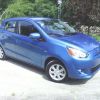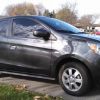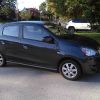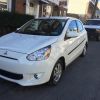UPDATE: You can read this thread for background info...but don't build the one I have described in this thread. Go to the link below to see how to build the "new and improved" version 2.0:
WAI Version 2.0
Background
I came up with this idea looking for an easy way to draw warm air into the intake from the exhaust manifold area. All you have to do is run a tube from the air box to the exhaust manifold to draw in warm air from that area. It sounds easy enough. But I didn’t want duct work running all over my engine compartment.
Here’s what I came up with…
I built a 1-piece intake tube device that’s about 10” long. One end of the device has a PVC flange that attaches to the back side of the air box…while the other end of the device is an aluminum tube that terminates about 1” above the exhaust manifold. It connects to the air box with 4 wing nuts. No tools are required for installation and it can be installed/removed in about 2 minutes.
Here’s the area behind the air box…
Here’s the finished product installed on the air box…
Here’s the engine compartment with the device installed. The factory snorkel/silencer stays in place…so you don’t get the intake noise that occurs when you remove it. Most people would never notice it mounted to the air box…
With the main intake snorkel blocked off (you can’t see this in the image above), all of the intake air is pulled in from the pipe directly above the exhaust manifold (where there’s lots of warm air).
Remove your air intake snorkel for a minute
To help understand this modification, take 2 minutes to remove your intake snorkel assembly so you can see behind the air box. The intake snorkel is a separate piece from the air box and is easily removed…
1) Remove the 10mm bolt holding the snorkel to the engine (the bolt near the oil filler cap).
2) Open the front of the air box and remove the air filter. You can now see where the snorkel connects to the air box.
3) There are 2 tabs that hold the snorkel to the air box. Push in on these tabs while pulling the snorkel assembly towards the passenger side of the car.
The assembly will come free at this point.
Now you can see behind the air box where this device is installed.
The Mirage’s air intake snorkel is not very big
The Mirage’s oval air intake snorkel is essentially a 1 7/8” inner diameter round pipe. Here’s how I came to this conclusion. I rolled a strip of paper into a small circle, and then expanded it out against the inside diameter of the snorkel where it attaches to the air box…
I taped the end of the paper to maintain the internal shape of the snorkel. The resulting paper (when removed from the snorkel and formed into a circle) is 1 7/8” in diameter. Place this same circle of paper inside a 2” diameter PVC plumbing pipe and the paper circle is noticeably smaller.
I assumed I would need to use 2” ID pipe when I started working on this idea. But based on these measurements, a 2” pipe may be overkill. That’s good…because there’s not much room to work with between the air box and cowl.
Where can you easily mount something to the back of the air box?
Once I knew what pipe to use, I needed to figure out how to connect it to the air box. I was looking for a good, flat surface to mount a flange where an intake tube could easily attach. That leaves you with one obvious area on the back of the stock air box that is shown below…
Here’s where I had to create a hole to mount the device. The air box material is strong and rigid where the hole is located. It's more than enough to support the device...which weighs less than 2 pounds.
Random thoughts/concerns
1. Does this device allow enough air flow?
One of my concerns was how much intake airflow (in CFM) does the engine require…and does this design support adequate airflow for the engine? At its most narrow point, my device is roughly 25% smaller than the inner diameter of the factory snorkel.
The PVC elbow flange I’m using reduces down to 1.625 inches inner diameter at its most narrow point. This represents a reduction of 25% when you compare the cross-section area inside the snorkel vs the cross section area inside the flange.
I’m somewhat concerned about what CFM can flow through my device…and is it adequate for the engine. I can’t find an easy calculation for this online…so I’m testing it on the fly. So far I’m not noticing any issues. I think it will be OK for my purposes since my car operates 99% of the time below 3200 RPMs. But I’ll admit that you probably wouldn’t want to do a 7,000 RPM dyno pull with this thing installed
2. Is there enough clearance to install something on the back of the air box?
This device did NOT have enough clearance when I first installed it. The PVC piece was only 1/8” away from the cowl. I could hear/feel the PVC vibrating against the cowl under certain conditions. Fortunately, I figured out how to gain the necessary clearance to eliminate the problem. Details in the next post below.
3. Does it work?
Initial testing in cold temperatures has been OK. My Scangauge is showing intake air temps 30-40 degrees above ambient at a 60 mph cruise. The slower you go, the higher the temperature increase. Stop and go city driving shows 40-50 degrees above ambient. Both of these tests were done with an ambient temperature between 28 degrees and a 90% grill block. Note: To get the most out of any Warm Air Intake, you are going to want to use it along with blocking most of the grill opening during colder temps.
The temperature was 0 this morning and I had an IAT of 35 degrees @60 mph. This is with a 100% grill block in place. When I slowed down to 45, the IAT increased into the mid 50s.
Right now the effectiveness of the device is limited…but could be improved. I think the problem is the gap between the exhaust manifold shield and firewall where outside air can enter the engine compartment.
I need to figure out a way to shield the intake tube from this airflow…as the outside air is holding down the temps of the intake air where my pipe is located. That’s what I’ll be working on next.
HOW-TO in the next post...



 Puttster 2
Puttster 2

 Reply With Quote
Reply With Quote )
)
 2015 Test Mirage
2015 Test Mirage Swarthy
Swarthy
 Shelby
Shelby Zero
Zero Zero Sen
Zero Sen

 2014 Mitsubishi Mirage ES
2014 Mitsubishi Mirage ES
 If you didn't have to manipulate the PVC fitting, this would be an easier project.
If you didn't have to manipulate the PVC fitting, this would be an easier project.

 Low buck tux
Low buck tux